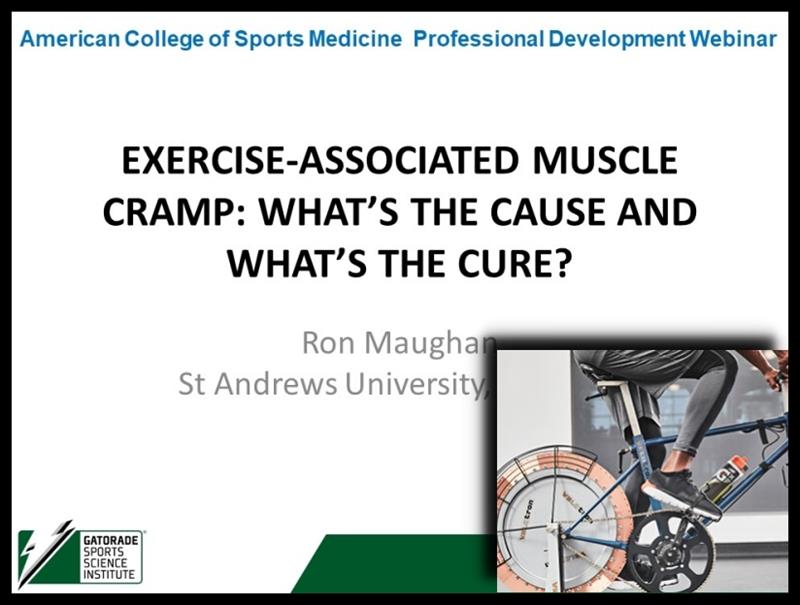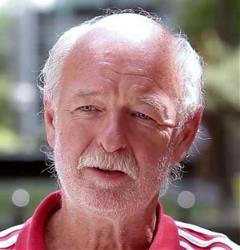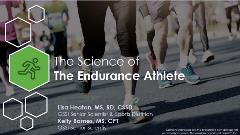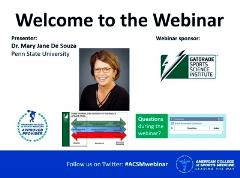Ron Maughan, Ph.D. |
March
18, 2020

The Gatorade Sports Science Institute (GSSI) and ACSM recently hosted an industry-presented webinar with Ron Maughan, Ph.D., entitled Muscle Cramping During Exercise. This is Part II of the Q&A.

Read Part 1 of the QnA here
Several questions were asked by attendees during the webinar and the answers pertaining to research, ageing and more are below.
Q: How does age relate to risk of muscle cramping?
Muscle cramps unrelated to exercise are certainly more common in older individuals, but the evidence of an age-related change in predisposition to exercise-associated muscle cramps is less convincing. This may in part simply reflect the fact that older individuals are less likely to participate in the activities that typically induce cramping. In a large survey of runners participating in a 21 km and 56 km race, Martin Schwellnus and his colleagues found that more experienced runners were more likely to report a history of exercise-associated muscle cramp (1). This may reflect the fact that more experienced runners are generally older, but a simpler explanation may be that they have had more training and racing opportunities to encounter cramp.
Q: I would appreciate if Dr. Maughan would address muscle cramping in the absence of fatigue, occurring at night. Also, age effects on muscle cramps.
Muscle spasms that are very similar to exercise-associated cramps are known to occur in many situations, some of which were referred to briefly in the webinar. It is very hard to know if there is a common cause underlying all of these different types of cramps, but the range of different situations in which they occur makes this seem unlikely. There are certainly many situations in which repetitive use of small muscles leads to cramps, and some of these have well-recognized names, such as writer’s cramp, typist’s cramp and telegraphist’s cramp: the common factor is repeated use of the small muscles of the hand and fingers, but fatigue – if there is any – is very different from the fatigue experienced by the runner or the games player. Cramps are also relatively common at night in older individuals and during pregnancy, as well as in some medical situations, including liver disease, some neurological conditions and during renal dialysis. Cramps are also reported as a side-effect of some medications. Again, we have to consider whether there is some common underlying mechanism. One thing that these conditions do tell us is that systemic changes can result in localised cramping in some muscles while others are not affected. This argument is often used to discount the systemic changes that occur with dyshydration and electrolyte changes as a cause of exercise-associated muscle cramps.
Q: What would you like to see done for further research on cramps?
It seems remarkable that after more than a century of investigation, something as common and as painful as muscle cramping is still not understood. In common with many others, I thought that this would be something I could solve, and we did some studies in the 1980s and 1990s. Like so many others, we were disappointed that we could make little progress. We did a prospective study in the 1982 Aberdeen marathon where we took blood samples from about 90 runners before and after the race and compared values for those who experienced cramp and those who did not. However, as should have been obvious, cramp is unpredictable, and samples were collected only after the end of the race: it was impossible to get samples at the time of cramping. We put out a call for volunteers in the running community who either never got cramp of who experienced cramp frequently. Several said that they cramped almost every time they ran. We brought them in to the laboratory, but not one of them experienced cramp even after several prolonged runs. Laboratory models that induce cramp artificially are interesting, but the cramps experienced may not be the same as those that occur spontaneously. Perhaps it needs someone who is cleverer than I am to devise a way of investigating this problem.
Q: When you do have a cramp, what can help with it immediately or during that moment of cramping?
The commonly accepted practice is to stretch the affected muscle. This seems to be effective and is stated in many published scientific papers to be effective, but most cramps resolve spontaneously within a very short time, so it is hard to know whether this really helps. Many commercial products are promoted as effective treatments for cramp, but the evidence that they shorten the duration or severity of cramping is totally absent for most of these products.
Q: How can I find the older studies which were presented in this presentation?
Many of the older publications are hard to track down and have therefore been largely forgotten. We have recently published a review paper that identifies many of these publications, and once you have the details of where they are published you can track many of them down on the internet (2). Others are available from libraries, and many public or university libraries are very helpful. They make for an interesting read, so it is well worth making the effort to find them. A forthcoming issue of the Sports Science Exchange, published by the Gatorade Sports Science Institute, will also give details of many of these publications.
References:
- Schwellnus MP, Swandevelder S, Jordaan E, Derman W, Van Rensburg DCJ. Underlying chronic disease, medication use, history of running injuries and being a more experienced runner are independent factors associated with exercise-associated muscle cramping: a cross-sectional study in 15778 distance runners. Clin J Sports Med. 2018;28(3):289-298.
- Maughan RJ, SM Shirreffs. Muscle cramping during exercise: causes, solutions, and questions remaining. Sports Med. 2019;49(Suppl 2):S119-S124. DOI: 10.1007/s40279-019-01162-1.
Presenter:

Ron Maughan, Ph.D., University of St Andrews| Scotland, UK
Ron obtained his BSc (Physiology) and Ph.D. from the University of Aberdeen and was based in the Medical School there for almost 25 years before moving to England. He is now Visiting Professor at St Andrews University. He spent much of his career trying to understand the physiological responses to exercise and the nature of fatigue but has included many digressions along the way. He chairs the Nutrition Working Group of the Medical and Scientific Commission of the International Olympic Committee and is a director of the IOC Diploma programs in Sports Nutrition, Sports Medicine and Sports Physical Therapies.
Viewpoints presented in this blog reflect opinions of the author and GSSI and do not necessarily reflect positions or policies of ACSM.
View More from GSSI

Industry-Presented Webinar FAQ Part I | Fueling the Extra Mile: The Science of the Endurance Athlete

The Female Athlete Triad & Sports Nutrition Strategies for Recovery Webinar Q&A